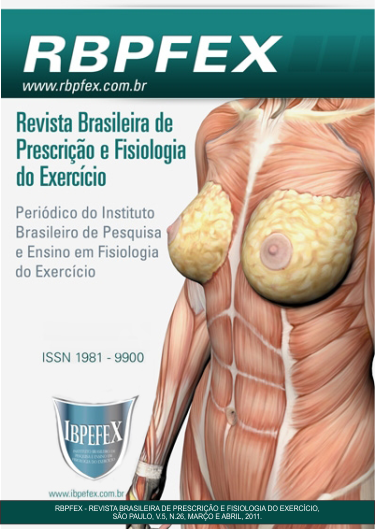Electromyographic fatigue evaluation of biceps brachial and extensor of the finger muscles.
Abstract
Objective: To analyze and compare values of median frequency (MF) and root mean square (RMS) in time, to quantify the change in these parameters depending on the installation of muscle fatigue. Methodology: The volunteers wereevaluated by Surface Electromyography (SEMG) and subjected to tests of isometric contractions of biceps brachii and extensor muscles of the fingers, with load percentage of 25% and 75% of its maximum capacity, in two different days, with at least 48 hours. Results: There was an increase of RMS for both muscles in two tests. This increase was more evident during exercise at 75% of maximum load for both biceps and extensor, and there was greater variation in the biceps muscle when compared with the extender.The variation of the FM was negative for both biceps and extensor, and more evident during exercise at 75% of maximum load. When comparing the two muscles the change occurred by increasing the load was a little higher at the biceps muscle. The installation time of fatigue for both muscles was higher in the protocol to 25% of maximum load. Conclusion: The fatigue installationwas directly proportional to the increase of load and the exerciseduration. The biceps brachialshowed higher fatigue than the extensor fingers, even at 25% and 75% of maximum capacity. It also had less tolerance to time, and have fatigued more quickly.
References
-Clarke, D.H. The influence on muscular fatigue patterns of the intercontraction rest interval. Med Sci Sports. Vol. 3. Num. 2. 1971. p. 83-88.
-Beck, T.W.; Housh, T.J.; Johnson, G.O.; Weir, J.P.; Cramer, J.T.; Coburn, J.W.; Malek, M.H. The effects of interelectrode distance on electromyographic amplitude and mean power frequency during isokinetic and isometric muscle actions of the biceps brachii. Journal of Electromyography and Kinesiology. Num. 15. 2005. p. 482–495.
-Blackwell, J.R.; Kornatz, K.W.; Heath, E.M. Effect of grip span on maximal grip force and fatigue of flexor digitorum superficialis. Applied Ergonomics. Num. 30. 1999. p.401-405.
-Diefenthaeler, R.F.; Vaz, M.A. Aspectos relacionados à fadiga durante o ciclismo: uma abordagem biomecânica. Rev Bras Med Esporte. Vol. 14. 2008. p. 472-477.
-Gonçalves, M. Eletromiografia e a identificação da fadiga muscular. Revista Brasileira de Educação Física e Esporte. Vol. 20. Num. 5. 2006. p. 91-93.
-Guyton, A.C.; Hall, J.E. Tratado de Fisiologia Médica. 10a ed., Rio de janeiro, Guanabara koogan S.A, 2002.
-Hermens, H.J.; Freriks, B.; Disselhorst-Klug, C.; Rau, G. Development of recommendations for SEMG sensors and sensor placement procedures. J Electromyogr Kinesiol. Vol. 10. 2000. p. 361-374.
-Lawrence, J.H.; DeLuca, C.D. Myoelectric signal versus force relationship in different human muscles. J Appl Physiol.1983; Num. 54. 1983. p. 1653–1659.
-Lind, A.R.; Petrofsky, J.S. Amplitude of the surface electromyogram during fatiguing isometric contractions. Muscle Nerve. Num. 2. 1979. p. 257–264.
-Miura, K.; Ishibashi, Y.; Tsuda, E.; Okamura, Y.; Otsuka, H.; Toh, S. The effect oflocal and general fatigue on knee proprioception. Arthroscopy. Vol. 20. Num. 4. 2004. p. 414-418.
-Oda, S.; Kida, N. Neuromuscular fatigue during maximal concurrent hand gripand elbow flexion or extension.Journal of Electromyography and Kinesiology. Num. 11. 2001. p. 281–289.
-Oliveira, A.; Gonçalves, M.; Cardozo, A.; Barbosa, F. Exercício rosca bíceps: influência do tempo de execução e da intensidade da carga na atividade eletromiográfica de músculos lombares. Rev. Port. Cien. Desp. Vol. 6. Num. 2. 2006. p. 170-178.
-O’sullivan, S.B.; Schmitz, T.J. Fisioterapia: avaliação e tratamento. 4a ed., Barueri –SP: Manole, 2004.
-Paula, R.H.; Vale, R.G.S.; Dantas, E.H.M. Relação entre o nível de autonomia funcional de adultos idosos com o grau de fadiga muscular aguda periférica verificado pela eletromiografia. Fitness & Performance Journal. Num. 5. 2006. p. 95-100.
-Silva, S.R.D.; Fraga, C.H.W.; Gonçalves, M. Efeito da fadiga muscular na biomecânica da corrida: uma revisão. Matriz. Vol. 13. Num. 3. 2007. p. 225-235.
-Silva, S.R.D.; Gonçalves, M. Análise da fadiga pela amplitude do sinal eletromiográfico. R. bras. Ci e Mov. Vol. 11. 2003. p. 15-20.
-Silva, S.R.D.; Gonçalves, M. Comparação de protocolo para verificação da fadiga muscular pela eletromiografia de superfície. Matriz. Vol. 9. 2003. p. 51-58.
-Silverthorn, D.U. Fisiologia Humana: uma abordagem integrada. 2 a ed., São Paulo: Manole, 2003.
-Taylor, J.L.; Gandevia, S.C. A comparison of central aspects of fatigue in submaximal and maximal voluntary contractions. J Appl Physiol. Num. 104. 2008. p. 542–550.
Authors who publish in this journal agree to the following terms:
- Authors retain the copyright and grant the journal the right of first publication, with work simultaneously licensed under the Creative Commons Attribution License BY-NC which allows the sharing of the work with acknowledgment of the authorship of the work and initial publication in this journal.
- Authors are authorized to enter into additional contracts separately for non-exclusive distribution of the version of the work published in this journal (eg, publishing in institutional repository or book chapter), with acknowledgment of authorship and initial publication in this journal.
- Authors are allowed and encouraged to post and distribute their work online (eg, in institutional repositories or on their personal page) at any point before or during the editorial process, as this can bring about productive change as well as increase impact and impact. citation of published work (See The Effect of Free Access).






